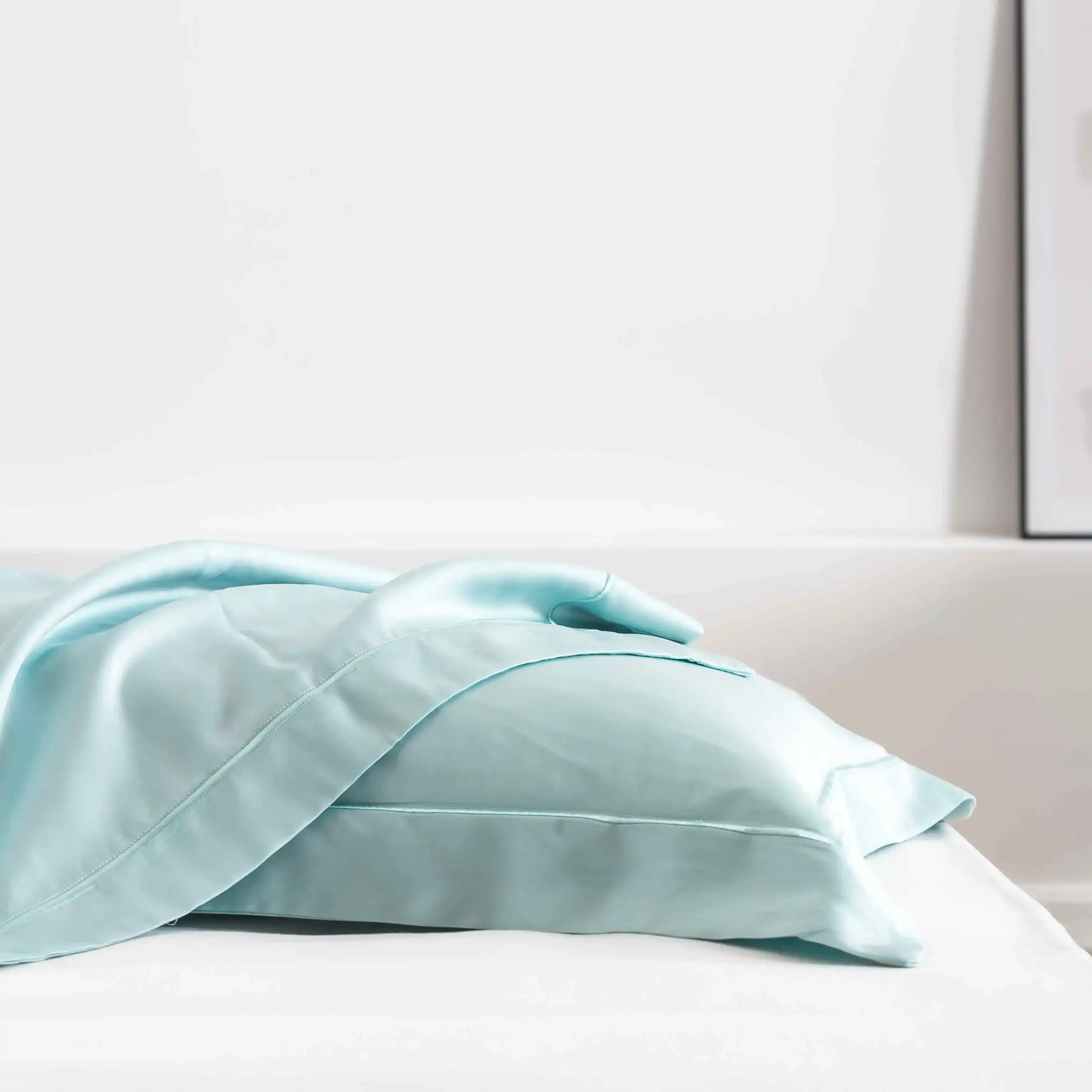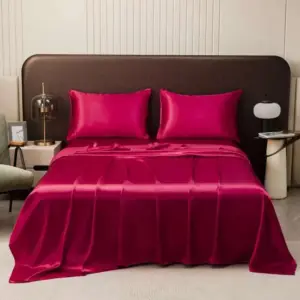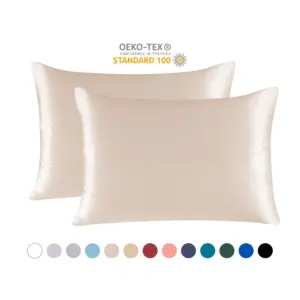Introduction: The Science of Silk for Hot Weather Sleep
Yes, silk bedsheets are excellent for hot weather! Their unique natural properties make them one of the best choices for keeping cool during warm summer nights. Unlike what many people believe, silk isn’t just a luxury fabric for winter use—it’s actually designed by nature to excel in temperature regulation year-round.
The secret lies in silk’s molecular structure. Silk fibers are composed of proteins arranged in a way that creates microscopic air pockets within the material. This structure gives silk its remarkable ability to adapt to your body temperature, whether it’s hot or cold outside.
For centuries, people in hot climates like India and China have relied on silk for its cooling properties. The natural temperature-regulating qualities of temperature regulation silk sheets make them particularly effective during summer months when staying cool becomes a priority for quality sleep.
Throughout this article, we’ll explore why silk performs so well in hot conditions, examine its key cooling properties, and compare it to other popular summer bedding options. We’ll focus specifically on premium Mulberry silk, which offers the optimal balance of cooling comfort and durability.
Temperature Regulation: How Silk Naturally Keeps You Cool
The exceptional cooling ability of silk comes from its natural thermoregulating properties. Unlike synthetic materials that trap heat, silk works with your body to maintain an ideal sleeping temperature.
How exactly does silk accomplish this remarkable feat? It all comes down to its unique fiber structure:
- Silk fibers are naturally hollow, creating tiny air pockets throughout the fabric
- These hollow fibers act as natural insulators that adjust to your body temperature
- The protein structure of silk allows it to efficiently conduct heat away from your body
- Silk feels cool to the touch, initially about 5-10 degrees cooler than room temperature
This natural ability to regulate temperature means that silk regulates temperature throughout the night, preventing the overheating that often disrupts sleep during hot weather. The material actively conducts excess heat away from your body when you’re too warm, helping maintain your body’s ideal microclimate within just 1-2 degrees.
Many people mistakenly believe silk is only appropriate for colder months because of its association with luxury and warmth. In reality, the thermal properties of silk bedding work year-round, adapting to conditions. This adaptability means silk keeps you cool in summer and warm in winter—truly a versatile bedding material.
The temperature regulation properties of silk are just one part of what makes it so effective for hot weather. Combined with its moisture management capabilities, silk creates the perfect environment for comfortable summer sleep.
Superior Moisture Management: Why You Stay Dry on Hot Nights
Perhaps one of the most impressive features of silk for hot weather is its exceptional moisture management. While many fabrics simply absorb sweat and become uncomfortably damp, silk handles moisture in a completely different way.
Silk has remarkable wicking properties, drawing moisture away from your skin rather than allowing it to accumulate. This crucial difference means that even on the hottest nights, silk helps keep your skin dry and comfortable. The material can absorb up to 30% of its weight in moisture without feeling wet against your skin—significantly outperforming most other natural fibers.
By comparison, cotton absorbs about 27% of its weight in moisture but tends to hold that dampness against your skin. This difference is why cotton sheets often feel clammy during hot, humid nights. Additionally, silk dries approximately 40% faster than cotton, which means any moisture it does absorb evaporates more quickly.
This moisture-wicking capability makes silk particularly beneficial for preventing night sweats and helping hot sleepers stay comfortable. Rather than waking up in damp sheets, silk bedding helps maintain a dry, comfortable sleep environment throughout the night.
The combination of temperature regulation and moisture management creates a double cooling effect that makes silk exceptionally well-suited for hot weather sleeping. Instead of trapping heat and moisture next to your skin, silk actively works to maintain comfort by moving both away from your body.
Exceptional Breathability: The Airflow Advantage
Alongside temperature regulation and moisture management, breathability forms the third pillar of silk’s summer comfort system. Breathability refers to a fabric’s ability to allow air to circulate freely through it, and silk excels in this regard.
The natural structure of silk creates microscopic air passages throughout the material. These tiny air channels allow for constant airflow around your body during sleep. This ventilation is crucial for hot weather comfort because it prevents heat from becoming trapped under your covers.
What makes silk particularly special is how it maintains this breathability despite having a relatively tight weave. Many fabrics with tight weaves tend to trap heat, but silk’s unique fiber structure allows air to circulate while still providing the smooth, luxurious feel that makes it so desirable.
For those specifically looking for options to combat summer heat, selecting breathable silk bedding for summer with optimized air permeability can make a significant difference in sleep quality. The enhanced airflow prevents the stuffy, overheated feeling that often accompanies hot weather nights.
This natural breathability works in harmony with silk’s other cooling properties. As your body releases heat, silk’s breathable structure allows that heat to dissipate rather than build up. Similarly, as moisture evaporates from your skin, the airflow through the fabric helps carry that moisture away, enhancing the cooling effect.
Understanding Momme Weight: Choosing the Right Silk for Summer
When shopping for silk sheets for hot weather, understanding momme weight is essential for making the right choice. Momme (pronounced “muh-mee”) is the measurement used to indicate the density and quality of silk fabric. It directly affects how the sheets will perform in warm conditions.
Here’s a simple breakdown of different momme weights and how they perform in hot weather:
| Momme Weight | Breathability | Durability | Best For Hot Weather? |
|---|---|---|---|
| 16-19 momme | Excellent | Lower | Very good – extremely lightweight and breathable |
| 19-22 momme | Very good | Good | Excellent – best balance of cooling and quality |
| 22-25 momme | Good | Very good | Good – still suitable but slightly heavier |
| 25+ momme | Moderate | Excellent | Fair – may retain more heat in extreme heat |
For optimal hot weather performance, sheets in the 19-22 momme range typically offer the best combination of breathability and quality. This weight provides enough substance for durability while maintaining excellent airflow and cooling properties.
Very lightweight silk (under 19 momme) might feel slightly cooler initially but tends to be less durable and may not stand up to frequent washing—a particular concern during summer months when you might need to launder bedding more frequently due to increased sweating.
Heavier silk (above 25 momme) offers exceptional durability and luxury but may not be quite as breathable during extremely hot nights. However, it’s worth noting that even heavier silk generally outperforms most non-silk alternatives in terms of temperature regulation.
The momme weight you choose should reflect your personal priorities—if maximum breathability is your main concern, opt for the lighter end of the spectrum; if you want a balance of cooling and longevity, the mid-range is ideal.
Silk vs. Other Summer Bedding Materials: A Comparative Analysis
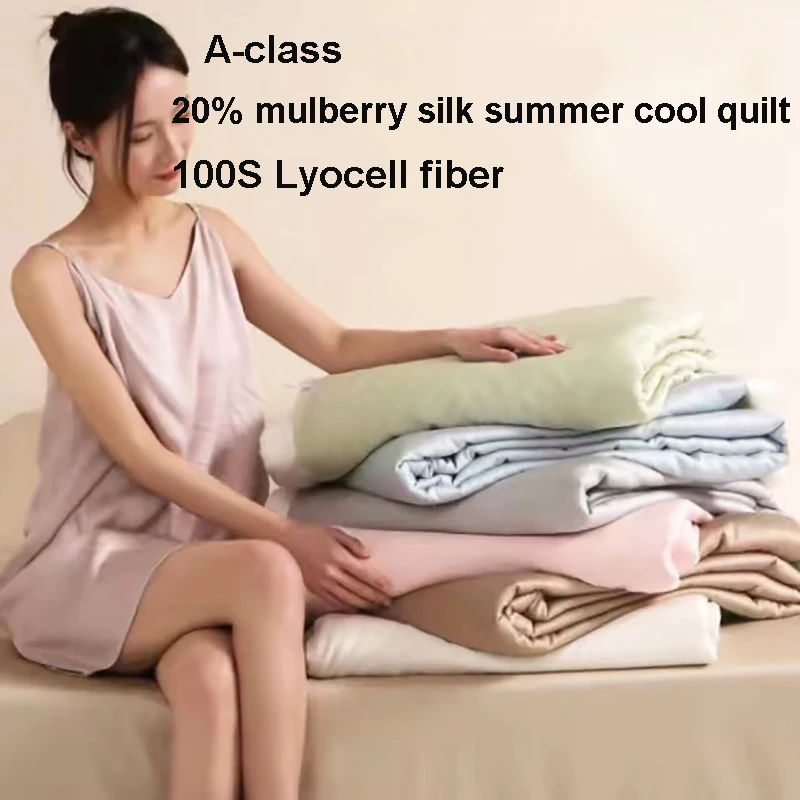
When evaluating summer bedding options, it’s helpful to understand how silk compares to other popular materials. Each fabric has distinct properties that affect its performance in hot weather.
Silk vs. Cotton
While cotton is often promoted as a breathable summer fabric, it has significant differences compared to silk. Cotton absorbs moisture rather than wicking it away, which can lead to that clammy feeling during hot nights. The differences between cotton and silk sheets become particularly noticeable for hot sleepers, as cotton tends to hold heat once it warms up.
Cotton advantages: More affordable, easy to care for, gets softer with washing
Silk advantages: Better temperature regulation, faster drying, smoother feel, doesn’t trap heat
Silk vs. Linen
Linen is another popular summer fabric known for its excellent breathability. However, its rough texture can be uncomfortable for some sleepers, and it wrinkles significantly more than silk.
Linen advantages: Very breathable, extremely durable, becomes softer over time
Silk advantages: Immediately soft, better moisture management, smoother against skin, less wrinkling
Silk vs. Bamboo
Bamboo sheets have gained popularity as an eco-friendly option with good cooling properties. While they perform well in hot weather, they don’t quite match silk’s natural temperature regulation.
Bamboo advantages: Less expensive than silk, environmentally sustainable, good moisture-wicking
Silk advantages: Superior temperature regulation, natural protein fibers benefit skin, more luxurious feel
Silk vs. Synthetic Cooling Fabrics
Many synthetic cooling fabrics are engineered specifically for temperature management, often using phase-change materials or moisture-wicking technologies. While effective, they lack silk’s natural feel and additional skin benefits.
Synthetic advantages: Often less expensive, easy care, specifically engineered for cooling
Silk advantages: Natural material, better for sensitive skin, regulates temperature naturally without chemicals
While each material has its merits, silk consistently offers the best overall performance for hot weather sleeping when all factors are considered. The initial higher investment typically pays off in comfort, especially for those who struggle with overheating at night.
Beyond Cooling: Additional Summer Benefits of Silk Bedding
While staying cool is a primary concern during hot weather, silk offers several additional benefits that make it particularly valuable for summer use:
Hypoallergenic Properties: Silk naturally resists dust mites, mold, and mildew—all of which can flourish in warm, humid environments. For those wondering if silk is good for allergies, the answer is a resounding yes. Silk reduces dust mite presence by approximately 70% compared to cotton, making summer nights more comfortable for allergy sufferers.
Reduced Friction: Silk’s incredibly smooth surface creates less friction against both skin and hair. This reduced friction (with a coefficient of just 0.7-1.0) means less irritation on hot, sticky nights when skin sensitivity may be increased. It can reduce sleep lines by up to 30% compared to cotton.
Hair and Skin Benefits: The smooth surface prevents the bed head and sleep creases common in hot weather when you might toss and turn more frequently. Additionally, silk contains natural proteins (sericin) that can benefit skin, helping maintain moisture balance.
Lightweight Feel: Unlike heavier winter fabrics, silk provides a lightweight, barely-there sensation that enhances comfort on warm nights. This physical lightness contributes to the psychological feeling of coolness.
Natural Protein Structure: As a protein-based fiber (similar to human hair), silk interacts with your body differently than plant-based fabrics like cotton or linen, creating a more harmonious sleeping environment.
These additional benefits make silk an excellent all-around choice for summer bedding, addressing not just temperature concerns but overall comfort and wellbeing during the hottest months of the year.
Does Silk Make You Sweat More? Addressing Common Concerns
One of the most common misconceptions about silk is that it causes increased sweating or feels too “hot” for summer use. Let’s address this concern directly:
Does silk make you sleep hot?
No, silk does not make you sweat more. In fact, studies show that many users report reduced night sweats when using silk bedding. The confusion likely stems from experiences with synthetic “silk-like” fabrics or very heavy momme weight silk used in inappropriate settings.
Why do some people think silk is hot?
Several factors may contribute to this misconception:
* Experience with synthetic satin (often mistaken for silk)
* Using very high momme weight silk (30+) in extremely hot conditions
* Improper care that has damaged silk’s natural properties
* Layering silk with non-breathable materials that trap heat
How to maximize silk’s cooling properties:
* Choose appropriate momme weight (19-22 for maximum cooling)
* Ensure you’re buying real Mulberry silk, not synthetic alternatives
* Follow proper washing instructions to maintain cooling properties
* Use silk sheets alone rather than layering with less breathable fabrics in extreme heat
Unlike synthetic materials that may feel cool initially but warm up throughout the night, properly maintained silk maintains a consistent temperature. If you’re concerned about silk’s performance in very hot conditions, starting with a pillowcase is a good way to experience its cooling benefits before investing in a full sheet set.
Summer Care Guide: Maintaining Your Silk Sheets in Hot Weather
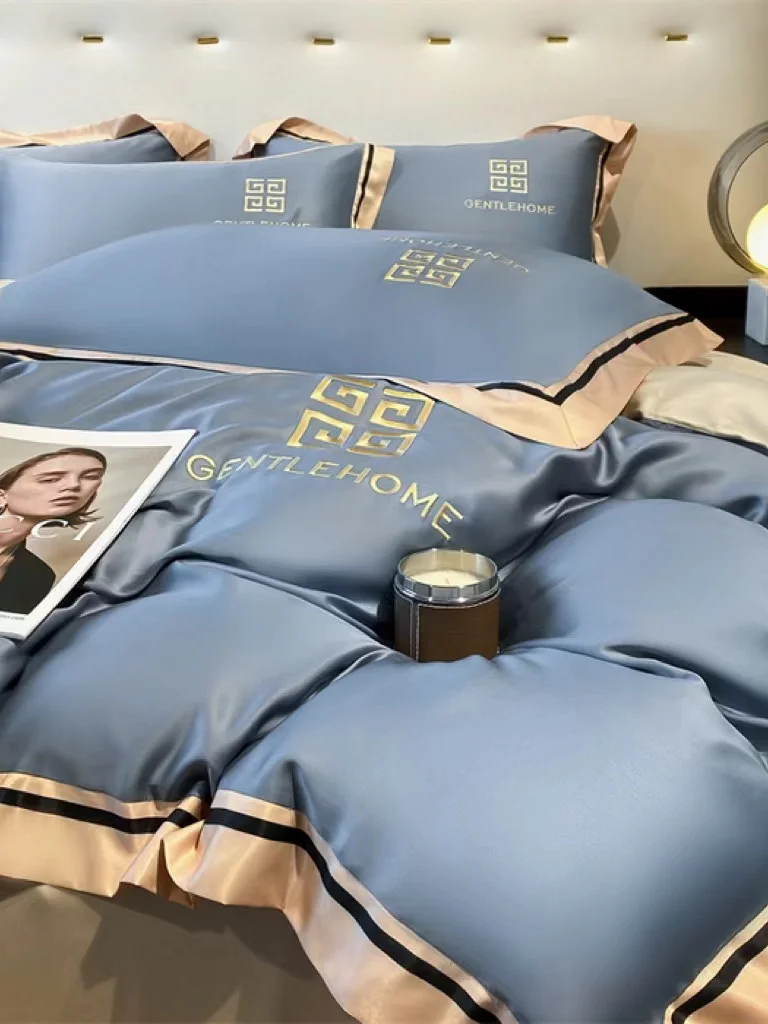
Proper care is essential for maintaining silk’s cooling properties, especially during hot weather when bedding may require more frequent washing. Follow these guidelines to keep your silk sheets performing at their best all summer:
Washing Instructions for Hot Weather
- Wash more frequently during summer (every 7-10 days instead of 10-14)
- Always use cold water (below 86°F/30°C)
- Select a gentle, silk-specific detergent free of enzymes and bleach
- Use the delicate cycle on your washing machine or hand wash
- Add a tablespoon of white vinegar to the rinse cycle to restore silk’s natural pH
Drying Techniques
- Never wring out silk sheets—press between towels to remove excess moisture
- Air dry in a shaded area away from direct sunlight
- Hang sheets over a non-metal rod to prevent creasing
- Avoid using dryers, even on low heat settings
- Ensure sheets are completely dry before storing to prevent mildew
Additional Summer Care Tips
- Rotate between two sets of washable silk sheets to extend their life during frequent summer washing
- Consider lighter colored cooling silk sheets as they absorb less heat than darker colors
- Store clean sheets in a cool, dry place away from direct sunlight
- Iron on the lowest silk setting only if necessary (most Mulberry silk sheets naturally release wrinkles when placed on the bed)
Proper care not only extends the life of your investment but also ensures your silk sheets maintain their maximum cooling potential throughout the hottest months of the year.
Frequently Asked Questions About Silk Sheets in Hot Weather
Is silk hot or cold to sleep on?
Silk is naturally temperature-regulating, meaning it feels cool when it’s hot and warm when it’s cold. In summer, silk’s thermal-regulating properties help dissipate body heat and keep you cool throughout the night.
What is the best momme weight for summer?
For optimal hot weather performance, choose silk sheets in the 19-22 momme range. This weight provides the ideal balance between breathability for cooling and durability for regular washing.
Do silk sheets keep you cool all night?
Yes, silk sheets maintain their cooling properties throughout the night. Unlike some materials that feel cool initially but warm up with body heat, silk continues to regulate temperature and wick moisture consistently.
Are silk sheets worth the investment for hot sleepers?
Absolutely. Hot sleepers often benefit most from silk’s cooling properties. The investment in high-quality queen size silk sheets or king size silk sheets typically pays off in improved sleep quality and comfort during hot weather.
Can silk sheets help with menopausal night sweats?
Many women report significant improvement in comfort during night sweats when using silk sheets. The combination of temperature regulation and moisture-wicking properties makes silk particularly effective for managing this common symptom.
Full-size Silk Sheets, King Size Silk Sheets, Queen Size Silk Sheets, Twin Size Silk Sheets, Washable Silk Sheets
Price range: $95.95 through $178.37 Select options This product has multiple variants. The options may be chosen on the product pageBamboo Silk Sheets, Cooling Silk Sheets
Price range: $130.76 through $177.80 Select options This product has multiple variants. The options may be chosen on the product pageKing Size Silk Sheets, Pink Silk Sheets, Silk Flat Sheets
$132.96 Select options This product has multiple variants. The options may be chosen on the product pageMulberry Silk Fitted Sheet, Mulberry Silk Sheets
Price range: $486.21 through $944.97 Select options This product has multiple variants. The options may be chosen on the product page100% Silk Sheets, Queen Size Silk Fitted Sheet, Queen Size Silk Pillowcases, Queen Size Silk Sheets
Price range: $259.05 through $284.13 Select options This product has multiple variants. The options may be chosen on the product page100% Silk Sheets, Mulberry Silk Pillowcases, Mulberry Silk Sheets
Price range: $105.03 through $121.45 Select options This product has multiple variants. The options may be chosen on the product page
Key Tips for Choosing Summer Silk Bedding
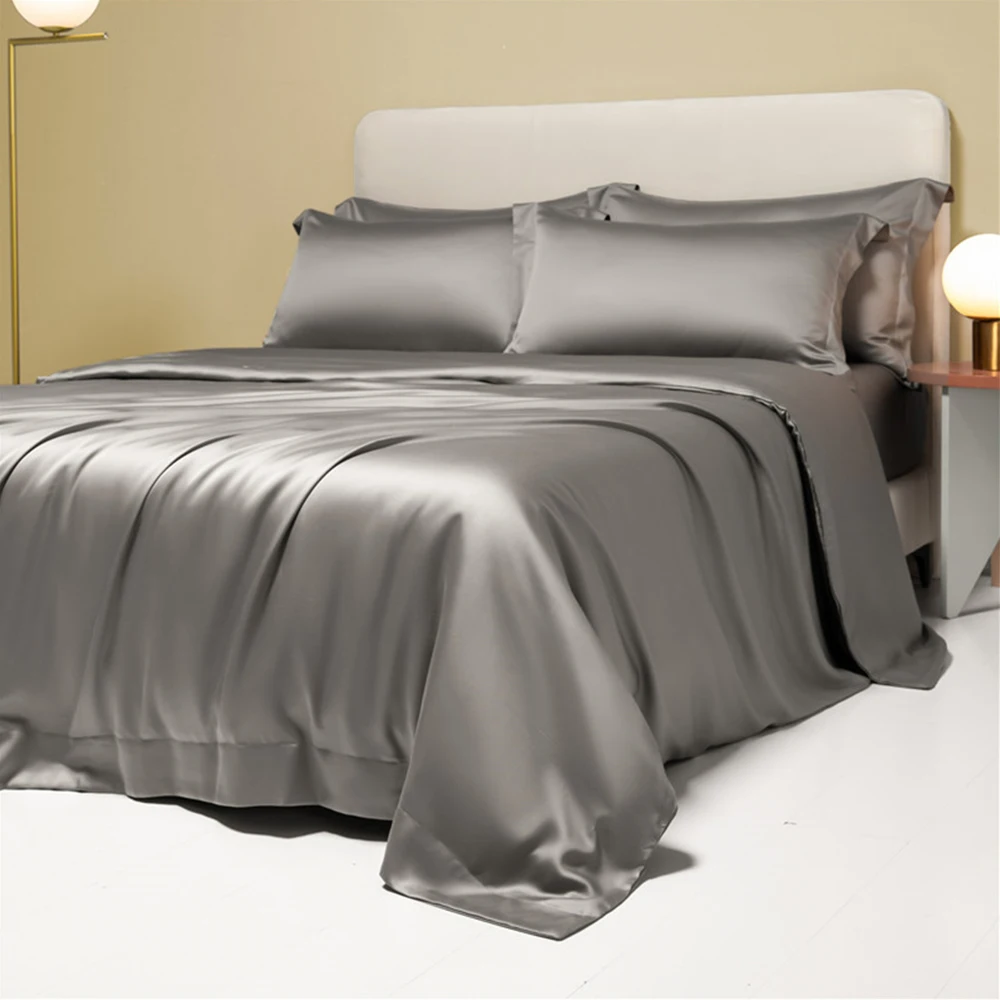
When shopping for silk bedding specifically for hot weather, keep these key considerations in mind to ensure you get the most cooling benefit from your investment:
Select the right momme weight: For maximum cooling, choose 19-22 momme silk. This range offers the ideal balance between breathability and durability for hot weather use.
Choose 100% Mulberry silk: Ensure you’re getting pure Mulberry silk rather than blends or synthetic alternatives. Pure silk provides the best temperature regulation and moisture management.
Consider color carefully: Lighter colors like white, ivory, and pale blue reflect heat better than darker colors. They’re generally the best choice for maximum cooling effect in hot weather.
Look for charmeuse weave: This classic silk weave optimizes the natural cooling properties of the material while providing the smooth, luxurious feel silk is known for.
Evaluate sheet set composition: For maximum cooling, consider whether you need a complete set or just a fitted sheet with pillowcases. Some hot sleepers prefer using a silk fitted sheet with a lightweight top sheet rather than a full silk duvet cover.
Check for certification: Look for OEKO-TEX or similar certifications that ensure the silk is free from harmful substances, which is particularly important when you might be sweating more in hot weather.
By choosing high-quality silk bedding with these cooling-optimized features, you’ll create the ideal sleep environment for hot summer nights. The right silk sheets can transform your summer sleep experience from hot and restless to cool and refreshing.

